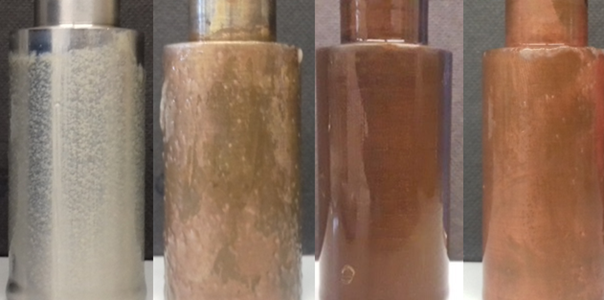
The present invention is a Multiple Cylinders Biofilm Reactor (MCBR) able to produce and to control large amounts of biofilms.
The reactor's configuration features distinct cylindrical surfaces for biofilm formation. An overhead stirrer provides the simultaneous rotation of cylindrical members under controlled speed using a synchronizing belt.
The possibility to replicate physical, chemical and biological conditions found on real industrial environments makes the present technology an attractive solution for disinfectant testing and validation.
Biofilms are heterogeneous and complex structures of microorganisms, typically adhered on a surface and presenting sophisticated singular and collective behaviours. The problems that biofilms cause to industrial surfaces and processes are significant and well described. For instance, in the food industry they are recognized as a source of recalcitrant contaminations, causing significant equipment damage, energy loss, food spoilage and are potential sources of public health problems due to outbreaks of foodborne pathogens. Accordingly, there has been a great deal of research to better understand the mechanisms promoting biofilm development and to identify efficient control strategies. However, effective strategies for biofilm inactivation, removal from surfaces and regrowth prevention are not clearly identified. This is in part due to the absence of standardized assays for biofilm formation and control, particularly for industrial biofilms.
The great innovation is the possibility to produce biofilms and to test new solutions for biofilm elimination in a single device. The MCBR reactor's configuration provides contoured surfaces, which mimic the surfaces in piping systems and provide higher sampling area than current alternatives.
The present technology allows the development of chemical and mechanical biofilm control strategies under the exact conditions used for biofilm formation. The reactor is designed to allow the application of different chemical treatments simultaneously, under controlled hydrodynamic conditions with replicates for each condition. Additionally, the device can operate under batch, fed-batch and continuous conditions
This MCBR category of reactor creates significant opportunities for applied industrial R&D in the fields of microbiology, biofilm production and biofilm elimination. Furthermore, as the MCBR allows two-in-one biofilm testing (biofilm formation and disinfection testing in a single device), this current reactor will help cleaning solutions' companies to ensure the efficiency of their disinfection solutions and establish accurate methods for controlling microbiological contamination. Control of contaminating microorganisms is crucial in food industry, in pharmaceutical companies and in other industrial sectors that deal with production and/or distribution environments that include surfaces that allow undesired biofilm formation, such as different piping systems.






